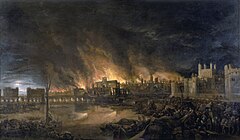Great Fire of London
The Great Fire of London happened in Central London in 1666. The fire lasted for just under five days, from 2nd September until 6th September.
 The Great Fire of London, September 1666. Painted by an unknown artist | |
| Date | 2–6 September 1666 |
|---|---|
| Location | London, United Kingdom |
| Cause | Bakery fire |
| Casualties | |
| 13,500 houses damaged | |
| 87 parish churches damaged | |
| Deaths | 6 |
It is believed to have destroyed the homes of 70,000 of the 80,000 people that lived in the city.[1] It is not known how many people died in the fire. Only a few deaths are certain, but for many of the victims there were no records. The fire may have cremated many, leaving no recognisable remains. It threatened the aristocratic district of Westminster (the modern West End), Charles II's Palace of Whitehall, and most of the suburban slums, however, it never reached these districts.[2]
The fire started at the bakery of Thomas Farriner (or Farynor) on Pudding Lane. It began just after midnight on Sunday 2nd September and grew very fast. Firefighters of the time usually made firebreaks by destroying buildings around the fire so it could not spread. This did not happen quick enough. Lord Mayor, Sir Thomas Bloodworth was not certain what to do. By the time he ordered such measures, it was too late. The Tower of London guard used gunpowder to make good firebreaks that stopped the fire from spreading to the east.
The fire pushed north on Monday into the center of the city. Some people thought that foreigners were setting the fires. They believed it was the French and Dutch, who at that time were England's enemies in the Anglo-Dutch Wars. On Thursday, the fire spread over most of the city, destroying St. Paul's Cathedral and crossed over the River Fleet. It was close to setting fire to Charles II's court at Whitehall.
The social and economic problems created from this were very large. Leaving London to go and live elsewhere was strongly encouraged by Charles II. He feared a London rebellion amongst the refugees who had lost their property. Despite numerous radical proposals, London was reconstructed on essentially the same street plan used before the fire.[3]
The fire is said to have also helped to get rid of the Great Plague which had hit London in 1665, and killed about 70,000 of the 90,000 population, who may have died in the fire. We are able to know a lot about the great fire of London because Samuel Pepys wrote in his famous diary at the time. When the fire started, he looked out of his window, saw the fire and started writing about it.
Damages
changeThe damages have been calculated to 13,500 houses, 87 parish churches, 44 Company Halls, the Royal Exchange, the Custom House, St Paul's Cathedral, the Bridewell Palace and other City prisons, the General Letter Office, and the three western city gates—Ludgate, Newgate, and Aldersgate.[4]
References
change- ↑ Tinniswood, Adrian (2003). By permission of heaven: the story of the Great Fire of London. London: Jonathan Cape. ISBN 9780224062268. 4, 101.
- ↑ Porter, Roy (1994). London: a social history. Cambridge: Harvard. ISBN 9780674538382., 69–80.
- ↑ Reddaway, T.F. (1940). The rebuilding of London after the Great Fire. London: Jonathan Cape., 27.
- ↑ Porter, 87–88.